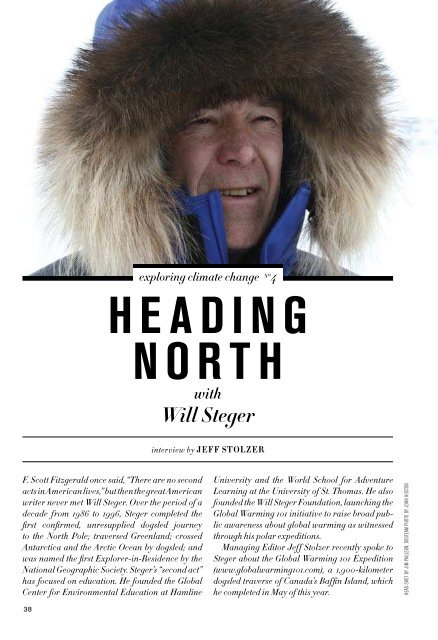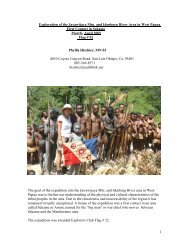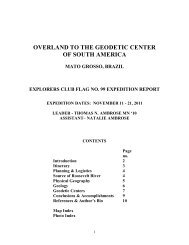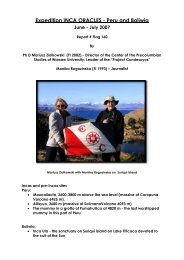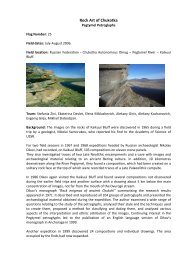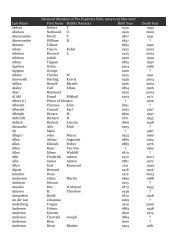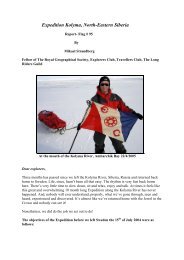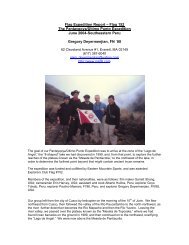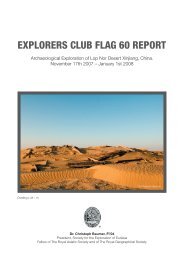the explorers journal the climate change issue - The Explorers Club
the explorers journal the climate change issue - The Explorers Club
the explorers journal the climate change issue - The Explorers Club
You also want an ePaper? Increase the reach of your titles
YUMPU automatically turns print PDFs into web optimized ePapers that Google loves.
exploring <strong>climate</strong> <strong>change</strong> No. 4<br />
h e a d i n g<br />
north<br />
with<br />
Will Steger<br />
F. Scott Fitzgerald once said, “<strong>The</strong>re are no second<br />
acts in American lives,” but <strong>the</strong>n <strong>the</strong> great American<br />
writer never met Will Steger. Over <strong>the</strong> period of a<br />
decade from 1986 to 1996, Steger completed <strong>the</strong><br />
first confirmed, unresupplied dogsled journey<br />
to <strong>the</strong> North Pole; traversed Greenland; crossed<br />
Antarctica and <strong>the</strong> Arctic Ocean by dogsled; and<br />
was named <strong>the</strong> first Explorer-in-Residence by <strong>the</strong><br />
National Geographic Society. Steger’s “second act”<br />
has focused on education. He founded <strong>the</strong> Global<br />
Center for Environmental Education at Hamline<br />
interview by Jeff Stolzer<br />
University and <strong>the</strong> World School for Adventure<br />
Learning at <strong>the</strong> University of St. Thomas. He also<br />
founded <strong>the</strong> Will Steger Foundation, launching <strong>the</strong><br />
Global Warming 101 initiative to raise broad public<br />
awareness about global warming as witnessed<br />
through his polar expeditions.<br />
Managing Editor Jeff Stolzer recently spoke to<br />
Steger about <strong>the</strong> Global Warming 101 Expedition<br />
(www.globalwarming101.com), a 1,900-kilometer<br />
dogsled traverse of Canada’s Baffin Island, which<br />
he completed in May of this year.<br />
head shot by Jim Paulson, dogteam photo by John Huston<br />
JS: One of <strong>the</strong> goals of <strong>the</strong> expedition was to visit<br />
Inuit living in remote villages and learn about <strong>the</strong>ir<br />
experience with <strong>climate</strong> <strong>change</strong>. What did <strong>the</strong><br />
Inuit share with you?<br />
WS: We traveled with three Inuit hunters who are all<br />
in <strong>the</strong>ir 50s or 60s, men who were born in igloos or<br />
huts. <strong>The</strong>y were nomadic and had a traditional culture<br />
when <strong>the</strong>y were young, so <strong>the</strong>y have seen all<br />
<strong>the</strong> <strong>change</strong>s. We also interviewed more than 100<br />
hunters, elders, and women in <strong>the</strong> villages to get<br />
<strong>the</strong>ir input. We were able to see <strong>the</strong> surroundings<br />
through <strong>the</strong>ir eyes so we got quite a bit of feedback<br />
on <strong>the</strong> expedition. It is remarkable how fast things<br />
are changing up <strong>the</strong>re. <strong>The</strong> Inuit are basically marine<br />
people who rely on <strong>the</strong> sea ice to hunt walrus, seal,<br />
and fish. In some areas <strong>the</strong>y do hunt caribou, but<br />
<strong>the</strong> sea ice is really <strong>the</strong>ir hunting platform and also<br />
<strong>the</strong>ir means of transportation. <strong>The</strong>y told us how <strong>the</strong><br />
reduction of sea ice by almost a third over <strong>the</strong> past<br />
year alone has affected <strong>the</strong>ir culture.<br />
<strong>The</strong> Inuit are noticing much<br />
later freeze-ups, anywhere<br />
from six weeks to two months,<br />
and <strong>the</strong>n earlier break-ups. In<br />
<strong>the</strong> area that we traveled in,<br />
<strong>the</strong> sea ice would normally be<br />
around for about nine months<br />
out of <strong>the</strong> year, but it’s now<br />
reduced to six months. Losing<br />
<strong>the</strong> sea ice, especially <strong>the</strong> summer sea ice, is real<br />
bad news for any animals like <strong>the</strong> walrus and polar<br />
bear that live on <strong>the</strong> sea ice, or a human being that<br />
relies on it for hunting.<br />
JS: What signs of global warming did you personally<br />
witness on your recent expedition?<br />
WS: <strong>The</strong> ice in Cumberland Sound—a large sound<br />
about 80 kilometers across and 190 kilometers<br />
long—had totally broken up at <strong>the</strong> end of January,<br />
which <strong>the</strong> Inuit hunters in that area said <strong>the</strong>y had<br />
never seen before. We normally would have crossed<br />
that sound to get to <strong>the</strong> village of Pangnirtung but<br />
we had to go around. It wasn’t a major deal but it<br />
cost us an extra three days and <strong>the</strong>n after we went<br />
around it, ano<strong>the</strong>r storm came in and broke up <strong>the</strong><br />
ice that we had just traveled on. It was also very obvious<br />
that <strong>the</strong> glaciers are in rapid retreat up <strong>the</strong>re.<br />
Ano<strong>the</strong>r thing we noticed was that in some areas<br />
thaws in <strong>the</strong> springtime and <strong>the</strong> summer and <strong>the</strong><br />
snow is melting all <strong>the</strong> way down to <strong>the</strong> ground and<br />
<strong>the</strong>n freezing solid in <strong>the</strong> winter, which is impacting<br />
<strong>the</strong> lemming population, which thrives under <strong>the</strong><br />
snow, where its warm. Small rodents, lemmings<br />
are <strong>the</strong> basic food for <strong>the</strong> wolf, <strong>the</strong> fox, to some<br />
extent <strong>the</strong> wolverine, and almost entirely for <strong>the</strong><br />
snowy owl. In areas where <strong>the</strong> lemming population<br />
is dropping, you have fox and wolf populations that<br />
are competing directly with <strong>the</strong> polar bear, because<br />
<strong>the</strong>y’re now going after <strong>the</strong> ring seals. So when you<br />
have one section of <strong>the</strong> food chain caving in, it<br />
affects <strong>the</strong> entire system because <strong>the</strong> chain is so<br />
delicate. And <strong>the</strong> Inuit kept pointing that out to us,<br />
very clearly. When it affects one, it affects all.<br />
But it is actually a lot more serious than that,<br />
because we are starting to upset <strong>the</strong> heat balance<br />
on <strong>the</strong> globe. Eighty percent of <strong>the</strong> extra heat that<br />
is now being captured on <strong>the</strong> surface of <strong>the</strong> globe<br />
because of human-induced global warming is being<br />
added to <strong>the</strong> ocean. So <strong>the</strong> whole ocean is warming<br />
and <strong>the</strong> sea level rise is probably due to this <strong>the</strong>rmal<br />
expansion of <strong>the</strong> warming ocean.<br />
This is being played out in <strong>the</strong><br />
Arctic, where we are starting to<br />
lose sea ice. In <strong>the</strong> summer we<br />
used to have ice on <strong>the</strong> Arctic<br />
Ocean in that nor<strong>the</strong>rn area<br />
that would reflect 99 percent of<br />
<strong>the</strong> energy of <strong>the</strong> sun back into<br />
<strong>the</strong> atmosphere. Now, with <strong>the</strong><br />
thawing of <strong>the</strong> ice, you’re getting exposed water and<br />
ground, which is a darker surface. That absorbs up<br />
to 96 percent of <strong>the</strong> sun’s energy. It’s like <strong>the</strong> difference<br />
on a hot sunny day between wearing a white<br />
t-shirt and a black t-shirt. That’s what is happening<br />
up north now, and that’s why we’re seeing this rapid<br />
<strong>change</strong> that is three to five times faster than down<br />
here.<br />
JS: Did you find evidence of global warming everywhere<br />
on your expedition or was it a more localized<br />
phenomenon?<br />
WS: It differs from region to region. Global warming<br />
isn’t a blanket warming of <strong>the</strong> Earth—some<br />
areas are actually getting colder. We saw that<br />
on Baffin Island. In some areas, <strong>the</strong>re were much<br />
stronger winds in <strong>the</strong> fall. And <strong>the</strong>y never had<br />
thawing wea<strong>the</strong>r before. As a result <strong>the</strong> snow was<br />
really hard-packed or iced up. And that affected<br />
<strong>the</strong> caribou—<strong>the</strong>re was virtually no game in that<br />
38 <strong>the</strong> <strong>explorers</strong> <strong>journal</strong>


